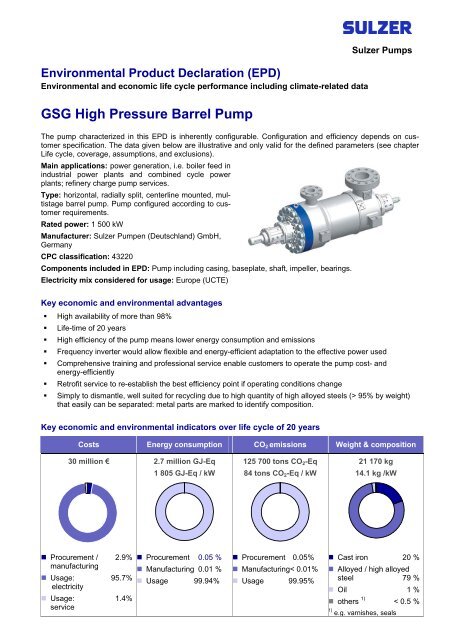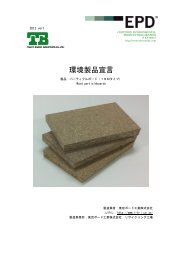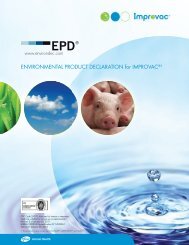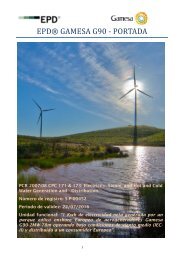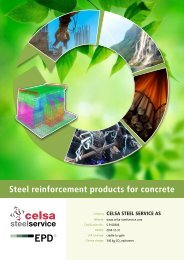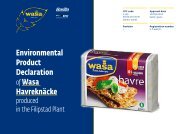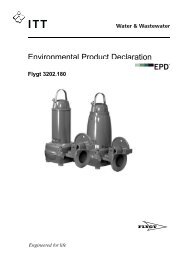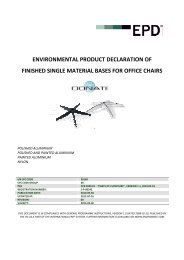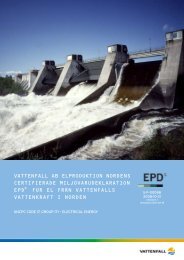GSG High Pressure Barrel Pump - The International EPD® System
GSG High Pressure Barrel Pump - The International EPD® System
GSG High Pressure Barrel Pump - The International EPD® System
Create successful ePaper yourself
Turn your PDF publications into a flip-book with our unique Google optimized e-Paper software.
Environmental Product Declaration (EPD)<br />
Environmental and economic life cycle performance including climate-related data<br />
<strong>GSG</strong> <strong>High</strong> <strong>Pressure</strong> <strong>Barrel</strong> <strong>Pump</strong><br />
Sulzer <strong>Pump</strong>s<br />
<strong>The</strong> pump characterized in this EPD is inherently configurable. Configuration and efficiency depends on customer<br />
specification. <strong>The</strong> data given below are illustrative and only valid for the defined parameters (see chapter<br />
Life cycle, coverage, assumptions, and exclusions).<br />
Main applications: power generation, i.e. boiler feed in<br />
industrial power plants and combined cycle power<br />
plants; refinery charge pump services.<br />
Type: horizontal, radially split, centerline mounted, multistage<br />
barrel pump. <strong>Pump</strong> configured according to customer<br />
requirements.<br />
Rated power: 1 500 kW<br />
Manufacturer: Sulzer <strong>Pump</strong>en (Deutschland) GmbH,<br />
Germany<br />
CPC classification: 43220<br />
Components included in EPD: <strong>Pump</strong> including casing, baseplate, shaft, impeller, bearings.<br />
Electricity mix considered for usage: Europe (UCTE)<br />
Key economic and environmental advantages<br />
• <strong>High</strong> availability of more than 98%<br />
• Life-time of 20 years<br />
• <strong>High</strong> efficiency of the pump means lower energy consumption and emissions<br />
• Frequency inverter would allow flexible and energy-efficient adaptation to the effective power used<br />
• Comprehensive training and professional service enable customers to operate the pump cost- and<br />
energy-efficiently<br />
• Retrofit service to re-establish the best efficiency point if operating conditions change<br />
• Simply to dismantle, well suited for recycling due to high quantity of high alloyed steels (> 95% by weight)<br />
that easily can be separated: metal parts are marked to identify composition.<br />
Key economic and environmental indicators over life cycle of 20 years<br />
Costs Energy consumption CO 2 emissions Weight & composition<br />
30 million € 2.7 million GJ-Eq<br />
1 805 GJ-Eq / kW<br />
125 700 tons CO 2 -Eq<br />
84 tons CO 2 -Eq / kW<br />
21 170 kg<br />
14.1 kg /kW<br />
• Procurement / 2.9%<br />
manufacturing<br />
• Usage: 95.7%<br />
electricity<br />
• Usage: 1.4%<br />
service<br />
• Procurement 0.05 %<br />
• Manufacturing 0.01 %<br />
• Usage 99.94%<br />
• Procurement 0.05%<br />
• Manufacturing< 0.01%<br />
• Usage 99.95%<br />
• Cast iron 20 %<br />
• Alloyed / high alloyed<br />
steel 79 %<br />
• Oil 1 %<br />
• others 1) < 0.5 %<br />
1) e.g. varnishes, seals
Functional unit<br />
<strong>The</strong> functional unit is 1 kW of rated hydraulic power at optimum efficiency.<br />
Composition of the product<br />
Material kg % 1) kg/kW 3)<br />
Cast iron 4'200 20% 2.80<br />
Alloyed / high alloyed<br />
steel<br />
16'675 79% 11.12<br />
Oil 192 1% 0.13<br />
Parts not included<br />
2)<br />
100 0% 0.07<br />
Total 21'167 100% 14.1<br />
1) By weight.<br />
2) Weight not included in assessment.<br />
3) Rated power.<br />
79% of the pump consists of alloyed and high alloyed<br />
steels, 20% of cast iron.<br />
<strong>The</strong> indicated quantity of oil refers to the initial fill of<br />
the pump, the oil is replaced every second year after<br />
installation.<br />
Remaining components such as paints and seals<br />
amount to less than 1% of the total weight and have<br />
as such been omitted.<br />
Material consumption during life cycle per pump 1) (material balance sheet)<br />
Procurement 2) Manufacturing at Usage / end of life<br />
Non-renewable<br />
Sulzer<br />
resources kg kg/kW kg kg/kW kg kg/kW<br />
Steel (alloyed), casting<br />
3) 3)<br />
for pump 21 600 14.40 20 900 13.93 20 900 13.93<br />
for spare parts 860 0.57 830 0.55 830 0.55<br />
Oil 1 900 1.27 1 900 1.27 1 900 1.27<br />
Waste production (total) n.a. n.a. 1 220 0.81 23 630 15.75<br />
Hazardous waste n.a. n.a. 150 0.10 1 900 1.27<br />
Municipal waste n.a. n.a. 270 0.18 n.a. n.a.<br />
Recycling (total) n.a. n.a. 800 0.53 21 730 14.49<br />
metals (pump) n.a n.a 700 0.47 20 900 13.93<br />
metals (spare parts) n.a. n.a. 30 0.02 830 0.55<br />
others n.a. n.a. 70 0.05 n.a. n.a.<br />
Renewable resources kg kg/kW kg kg/kW kg kg/kW<br />
Wood (packaging) 370 0.25 360 0.25 360 360<br />
Water consumption 4) n.a. n.a. 30 700 20.47 n.a. n.a.<br />
n.a.: not available, values per kW related to 1 500 kW rated power.<br />
1)<br />
Material resources related to supply of energy to site are not considered.<br />
2) Covers all resources procured during the life cycle by Sulzer, including the oil used to operate the pump.<br />
3)<br />
Machining during the manufacturing produces recyclable waste of around 4% by mass of the metals bought in.<br />
4)<br />
In manufacturing: used for testing purposes.<br />
page 2/6
Primary energy consumption during life cycle (primarily from usage / end of life)<br />
Procurement 2)<br />
GJ-Eq GJ-<br />
Eq/kW<br />
Electricity 94.6 0.06<br />
Gases 1) 7.0 0.005<br />
Fuel oils 32.6 0.02<br />
6) 6)<br />
6) 6)<br />
6) 6)<br />
Usage / end of life 3)<br />
GJ-Eq<br />
Manufacturing at<br />
Sulzer<br />
GJ-Eq GJ-<br />
Eq/kW<br />
GJ-<br />
Eq/kW<br />
GJ-Eq/<br />
Total<br />
GJ-<br />
Eq/kW<br />
2 706 900 1 805 2 707 000 1 805<br />
0 0 7.0 0.005<br />
0 0 32.6 0.02<br />
Materials 1 466 0.98 0 0 0 0 1 466 1.0<br />
Transportation 31.4 0.02 55.9 0.04 459 0.31 546 0.36<br />
Disposal, waste<br />
water 7) n.a. n.a. 0.4
Life cycle – coverage, assumptions, and exclusions<br />
<strong>System</strong> boundary: <strong>The</strong> EPD covers all relevant<br />
environmental aspects in relation to the life cycle<br />
phase diagram below.<br />
<strong>The</strong> construction of buildings, production machinery<br />
and transport infrastructure are all excluded.<br />
Manufacturing and usage of the motor, frequency<br />
inverter, and the piping used to operate the pump<br />
are excluded from the functional unit.<br />
Procurement includes the extraction of raw materials<br />
and production of semi-finished products,<br />
consumables, and energy by suppliers. Production<br />
data were converted into environmental effects via<br />
factors from the EcoInvent Database; based on the<br />
component parts for this product as assembled by<br />
Sulzer.<br />
<strong>The</strong> consideration of externally sourced parts has<br />
been limited to the casing, baseplate, shaft, impeller,<br />
motor, gearbox, and bearings; which together<br />
account for over 99% of the product weight.<br />
Due to low masses or rates of usage, small components<br />
such as solvents, varnishes and plastics<br />
(for e.g. seals) have not been included.<br />
Manufacturing at Sulzer covers all product manufacturing<br />
activities undertaken at the manufacturing<br />
site including engineering, welding, grinding,<br />
machining, painting and assembly. Data used are<br />
drawn from the yearly Sulzer SEED data collection<br />
which includes energy (e.g. electricity, natural gas,<br />
butane, propane, fuel oils, district heating, coal and<br />
coke etc.) water consumptions and waste water,<br />
emissions to air and waste production. <strong>The</strong> energy<br />
used includes both manufacturing and on-site office<br />
activities. <strong>The</strong> emissions to air from the use of<br />
paints and solvents are included, however related<br />
consumption of the varnishes and paints are excluded.<br />
<strong>The</strong> environmental burden from waste and<br />
wastewater treatment has been calculated using<br />
factors from the EcoInvent Database.<br />
<strong>The</strong> pump is assembled in Germany, and the<br />
mean European Union emissions factor for the<br />
electricity generating mix has been applied.<br />
<strong>The</strong> packaging of the pump for transport to the<br />
customer is a wooden crate, which has been included.<br />
Usage / end of life includes the usage and servicing<br />
of the product. It includes the production and<br />
disposal of spare parts and of oil.<br />
<strong>The</strong> motor and frequency inverter are not part of<br />
the system. <strong>The</strong> electricity consumption of the<br />
pump has therefore been calculated assuming an<br />
efficiency of both to 100%.<br />
<strong>The</strong> pump is used in Europe, the European energy<br />
(UCTE) mix was assumed. <strong>The</strong> price for electricity<br />
applied is € 0.10.<br />
<strong>The</strong> yearly costs for maintenance are set at 2% of<br />
the purchase price of the pump, and the assumed<br />
average increase in prices is at 2% per year.<br />
4% of the total weight of the pump is typically replaced<br />
during the lifetime and includes bearings,<br />
seals, impeller, and wearing rings.<br />
For recycling purposes, a credit of 50% of the initial<br />
materials burden to produce the pump has<br />
been assumed.<br />
Costs and effects of dismantling are not considered<br />
and are assumed minor compared with the<br />
usage phase. Monetary benefits through selling<br />
the pump as scrap have not been considered, as<br />
the lifetime of the product is too long to make a robust<br />
estimate).<br />
Spent oil is disposed as hazardous waste and incinerated<br />
accordingly; its environmental effects<br />
have been calculated based on factors from the<br />
EcoInvent Database.<br />
Transportation to Sulzer (depending on the location<br />
of the supplier, variously by truck, train, ship or<br />
airplane) is included in the procurement phase.<br />
Transportation to the customer following the manufacturing<br />
phase is by truck, and transportation for<br />
service activities in usage is by van for service at<br />
the customer site, or by truck if the pump is serviced<br />
at Sulzer’s site. Transportation of the dismantled<br />
pump at the end of its working life is not<br />
considered.<br />
Allocation: For manufacturing, data collected on<br />
the annual consumption of energy and water,<br />
emissions to air, waste water and waste production<br />
(from SEED) have been divided by the total<br />
number of pumps produced by the site to estimate<br />
the resource consumption per pump. For procurement<br />
and usage all resources, emissions, and<br />
wastes have been fully allocated to the pump.<br />
Referenced period for underlying data: Data<br />
taken from the Sulzer SEED database and<br />
EcoInvent database origin from the year 2009.<br />
page 4/6
Applied load levels of pump during life cycle<br />
<strong>The</strong> applied load levels are summarized in the table below. Based on expected usage characteristics advised<br />
by customers, the pump is expected to be operated at full load throughout its life.<br />
Duration of Operating hours Efficiency η<br />
Power<br />
Phases of<br />
phase<br />
per year<br />
consumption<br />
load level years hours/year % kW<br />
Phase 1: full load 20 8 000 75% 1 500<br />
Phase 2: middle load 0 0 0% 0<br />
Phase 3: low load 0 0 0% 0<br />
Glossary<br />
Life cycle assessment, LCA is a management<br />
tool for appraising and quantifying the total environment<br />
impact of products or activities during the<br />
entire life cycle.<br />
Life cycle costs are based on LCAs and cover<br />
the total costs of a product during the entire life cycle<br />
from the extraction of resources to the disposal<br />
of the product.<br />
Photochemical ozone creation potential, POCP<br />
refers to the change in of ground-level ozone concentration<br />
potentially caused by the emission of 1<br />
kg of a gas compared to that from the emission of<br />
1 kg of ethene.<br />
SEED is the database that Sulzer uses to collect,<br />
validate, and report on social, economic, and ecological<br />
data.<br />
A Functional Unit is a concept that is used to<br />
compare the life cycle costs of different products<br />
on a like-for-like basis.<br />
CPC (Central Product Classification) is a UNbased<br />
scheme for statistical division of product<br />
categories and service types.<br />
EcoInvent Database contains international industrial<br />
life cycle inventory data.<br />
Acidification occurs through deposition of soluble<br />
sulphur and nitrogen compounds from agricultural<br />
and combustion processes. Acidification can be<br />
harmful to sensitive ecosystems.<br />
Eutrophication is the often anthropogenic enrichment<br />
of bodies of water by nitrates and phosphates.<br />
This increases the growth of aquatic plants<br />
that deoxygenate water and outcompete other<br />
aquatic life.<br />
Global warming potential, GWP is the potency of<br />
1 kg of a gas as a radiative forcing agent relative<br />
to an emission of 1 kg of carbon dioxide over 100<br />
years.<br />
Ozone depletion potential, ODPs are calculated<br />
as the change that would result from the emission<br />
of 1 kg of a substance compared to that from the<br />
emission of 1 kg of CFC-11 (trichlorofluoromethane).<br />
page 5/6
EPD program<br />
<strong>The</strong> international EPD system, managed by the <strong>International</strong><br />
EPD Consortium (IEC).<br />
www.environdec.com.<br />
Applied standards and limitations<br />
<strong>The</strong> document was prepared based on the EPD<br />
General Program Instruction, the product specific<br />
requirements for submersible pumps and mixers,<br />
and the ISO 14025:2010 standard.<br />
Environmental product declarations from different<br />
programs with different product category rules may<br />
not be comparable.<br />
EPD number and time of validity<br />
<strong>The</strong> IEC number of this EPD is S-EP-00266, it is<br />
valid until 2012-02-24.<br />
Verification<br />
<strong>The</strong> EPD has been externally verified by Atkins<br />
Ltd, United Kingdom. <strong>The</strong> verification was undertaken<br />
in two sections; a review of the relevant documentation<br />
followed by a review of underlying data<br />
using a combination of a desk based review, a<br />
site visit and information exchange with Sulzer.<br />
Sulzer <strong>Pump</strong>s<br />
Sulzer <strong>Pump</strong>s is a world leader in reliable products<br />
and innovative pumping solutions. <strong>The</strong> global network<br />
of modern manufacturing and packaging facilities<br />
together with sales offices, service centers<br />
and representatives located close to major markets<br />
provide fast responses to customer needs.<br />
Sulzer <strong>Pump</strong>s has a long history of providing innovative<br />
pumping solutions to business partners in<br />
the following industries: Oil and Gas, Hydrocarbon<br />
Processing, Pulp and Paper, Power Generation,<br />
General Industry, Chemical Process Industry, Water<br />
and Wastewater<br />
All manufacturing sites operate business managements<br />
systems certified to ISO 9001, ISO<br />
14001, and OHSAS 18001.<br />
Sustainability program of Sulzer<br />
Sustainability is a key factor for the success of<br />
Sulzer. <strong>The</strong> company is committed to creating<br />
long-term economic value, while proactively assuming<br />
its social and environmental responsibility.<br />
Sulzer continuously assesses its sustainability activities.<br />
Extensive programs have been initiated to<br />
meet the expectations of Sulzer’s stakeholders.<br />
References<br />
<strong>The</strong> <strong>International</strong> EPD Cooperation, EPD General<br />
Instructions for Environmental Product Declaration,<br />
EPD Version 1.0; 2008-02-29.<br />
<strong>The</strong> Swedish Environmental Management Council;<br />
Product-Specific Requirements, Submersible<br />
pumps and mixers; PSR 2002:5; 2002<br />
Swiss Center for Life Cycle Inventories, EcoInvent<br />
Database 2.1, St. Gallen, 2009<br />
Environmental labels and declarations – Type III<br />
environmental declarations – Principles, EN ISO<br />
14025:2010, Berlin 2010<br />
Further information about products of Sulzer<br />
<strong>Pump</strong>s can be found at<br />
http://www.sulzerpumps.com/products<br />
This and other EPDs are available online at<br />
www.sulzer.com/sustainability.<br />
Further information about Sulzer: www.sulzer.com<br />
Further information about the Sulzer sustainability<br />
program: www.sulzer.com/sustainability<br />
Disclaimer<br />
<strong>The</strong> EPD has been prepared to the best of Sulzer<br />
Ltd's knowledge. However, the data, figures and<br />
results are shown for illustration purposes only and<br />
Sulzer Ltd cannot assume any liability as to the<br />
quality of such data, figures and results. Any warranty<br />
or representation, whether express or implied,<br />
shall be excluded.<br />
<strong>The</strong> EPD is published by Sulzer Ltd, Corporate<br />
QESH, 8401 Winterthur, Switzerland, © February<br />
22, 2011. For questions and feedback please contact<br />
sustainability@sulzer.com.<br />
page 6/6


